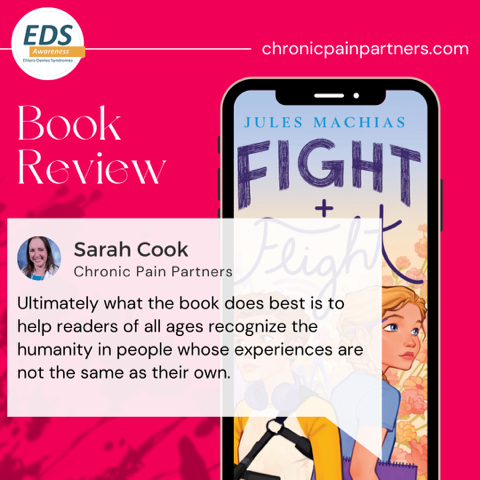
[CW: The book features an active shooter drill and talks about gun violence. This might be triggering to some people. The review is written so that an adult audience, as well as a younger audience, can get an impression of this book, but please keep in mind the potential triggers.]
Chronic Pain Partners is excited to introduce the EDS community to the new middle-grade* fiction book “Fight + Flight,” which features a character with EDS! In an exclusive interview for our July EDS Newsletter, journalist Karina Sturm spoke with author Jules Machias about their EDS journey and motivation to write Fight + Flight. [You can read the interview HERE.. Additionally, writer and PA Sarah Cook read Machias’ book, and we hope you’ll enjoy Cook’s review of “Fight + Flight” below.
In their new book, “Fight + Flight,” author and zebra Jules Machias (they/them) expertly presents the struggle of a kid adjusting to a new diagnosis of EDS and other critical challenges kids in the middle grades can face, such as questioning their identity. However, that’s not all that makes the storyline of this book so captivating!
Highlighting the challenges of physical and mental health conditions in one book!
The main characters in “Fight + Flight” are middle school classmates Avery and Sarah. Avery Hart has been diagnosed with EDS recently and is recovering from shoulder surgery. She is figuring out how to adjust to these significant changes in her life – living with a chronic illness as a child – while those around her are learning how to best support a young person with a physical chronic illness and disability. Classmate Sarah Bell, on the other hand, has just lost two people she was close to recently, and additionally to grieving and coping with those losses, she lives with anxiety and panic attacks.
At the beginning of the book, the girls’ school has a hyper-realistic active shooter drill to teach the students to take those events seriously. The school decided to incorporate lots of sound effects to scare the children, so they would understand that they need to be prepared for a situation like that. Their plan works: The kids don’t realize it’s an exercise and experience the longest 90 seconds of their lives.
Avery and Sarah are both traumatized by the experience but react very differently as a consequence. Avery, at first, is angry because after her EDS diagnosis, she was already feeling incredibly vulnerable. She formulates a plan to get revenge on the principal and wants to show him how scary a drill like this can be by setting off fireworks outside his house. Sarah is surprised by her reaction. She has been living with intense panic attacks recently, but felt strangely calm during the drill.
Avery asks Sarah’s older brother for help, who has some unresolved conflict with the principal himself, because he was kicked out of the district when he was Avery’s age. Sarah, on the other hand, is more for a peaceful approach and gathers her fellow classmates to support her petition for a change in district policy.
Why disability representation matters!
The fact that Machias created characters with different chronic illnesses/disabilities – physical and mental health conditions, as well as invisible and visible disabilities – is crucial for the 4.3 percent of disabled children or the 17 percent of children aged 12 – 17 who have more than one chronic condition in the US. They all want to be seen and heard, but books don’t commonly talk about disability or illness, even though quite a large number of middle-grade kids are affected.
Machias did a beautiful job explaining in an age-appropriate manner the challenges that come along when living with an invisible disability, such as the mental health conditions Sarah is experiencing, as well as with a more visible disability, like Avery’s shoulder surgery which required her to wear a shoulder brace. Personally, I don’t know any other middle-grade book which focuses on a person with Ehlers-Danlos syndrome, and in general, resources for children/young adults with EDS seem sparse. So Machias’ efforts to represent young rare disease patients will be validating for all these young EDSers reading the book and seeing themselves in Avery.
Book Review: “Fight + Flight” – The new middle-grade book featuring a character with EDS!
Machias also made sure to thematize mental health struggles in a very respectful and relatable way in order to destigmatize anxiety, panic attacks and PTSD and cause more understanding between people with mental health issues and the healthy population. At the same time, the characters’ different reactions to the shooting drill and how they are working through their trauma put an emphasis on coping and resilience in a playful manner.
The author also integrates those illnesses/disabilities quite naturally into the storyline but without a focus on the illness. It’s more like they are a natural part of the characters’ lives which normalizes disability as a part of the human experience.
Exploring identities.
Another storyline revolves around Sarah and Avery both trying to sort out their feelings for each other on their own. Avery is pansexual, meaning she is attracted to all gender identities. She’s grown up with two moms, one of whom is trans, who have raised her to celebrate her identity, whatever she decides that is. Avery likes Sarah but is hesitant to tell her.
Sarah, on the other hand, is trying to reconcile her feelings for Avery with her religious upbringing with two pretty conservative parents. Sarah had previously thought of herself as straight. She realizes, though, that she likes Avery. She is trying to process that in the context of her parents’ repeated suggestions that she should pray her panic away without providing her much additional support in negotiating her symptoms.
Disability and LGBTQ+ representation in one book.
Living with a disability as a person who additionally belongs to the LGBTQ+ community comes with many additional challenges, as Machias manages to explain well in this book. While Avery struggles with her chronic illness but seems to be fully comfortable with her identity already, Sarah is still in the process of figuring out both – a situation that more or less happens for all children or young adults.
In understandable words and incorporated into the storyline, Machias shows a common intersection: disability and LGBTQ+ identities. In fact, more than 30 percent of people in the LGBTQ+ community live with a disability. And standing with one foot in each of those worlds can feel lonely sometimes, especially for children who aren’t sure about their identity in the first place.
Machias was able to represent several marginalized communities and the challenges each group has while additionally highlighting the intersection between them. And they did so in a way children will feel understood and validated while parents might get new insight into the minds of their children.
Summary: A great book for all ages.
In Chronic Pain Partners’ July newsletter, Machias explained their passion for writing stories that help kids feel seen, understood, and hopeful, especially when they live with a chronic illness like EDS. These are fundamental needs all of us have and are particularly important for kids as they grow and learn about the world around them. Machias‘ book ticks all those boxes and some more.
Combining chronic illness/disability with the search for one’s identity was a brave undertaking by Machias. Both of these areas are incredibly tough to explain on their own, but throwing them together and focusing on the intersection between disability and sexual identity/orientation in a book made for children aged 8 – 12 (middle-grade) can only be successfully done by a person who has lived experience with all of the mentioned topics. It seems as if Machias brought in their own identities as a non-binary, chronically ill person and wrote a book they would have wished to have when they were a child.
The story realistically explores multiple complex issues that so many kids this age have to confront today. The portrayal of these obstacles felt both accurate and age-appropriate. Seeing those characters in the middle grades coming out of the other side of the challenges with a surer understanding of who they are was beautiful. The author’s approach accomplishes this in a way that kids reading the story will find relatable because they will see their everyday life and problems in Avery and Sarah. The book will also help caregivers better understand what challenges the middle grades often face and therefore hopefully be enabled to react in a positive and constructive way as a result.
The book’s portrayal of getting a diagnosis and adjusting to it was right on target. Many zebras will relate to the frustrations Avery feels and her process of learning to draw on the strength she already has inside her. It’s a story that also raises awareness for people of any age who may not be as familiar with EDS as zebras and their families. Increasing awareness about EDS, particularly in books, is so important!
Ultimately what the book does best is to help readers of all ages recognize the humanity in people whose experiences are not the same as their own.
If you want to learn more about Jules Machias and “Fight + Flight,” visit their website:
Or read our interview with Machias:
*Middle-grade refers to ages 8 – 12.
By Sarah Cook
September 2022


